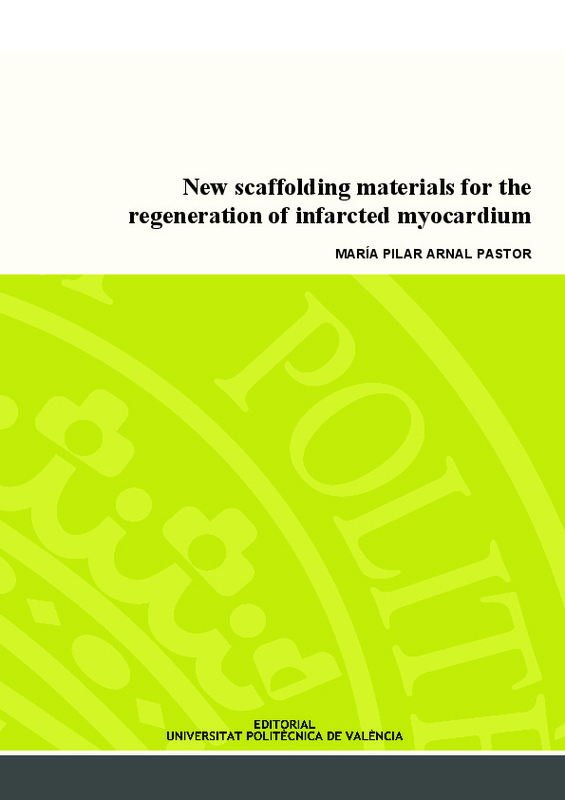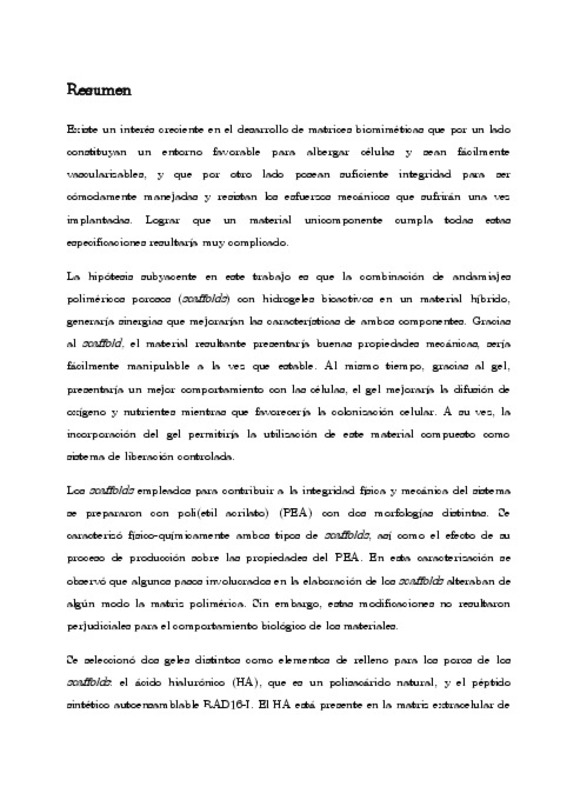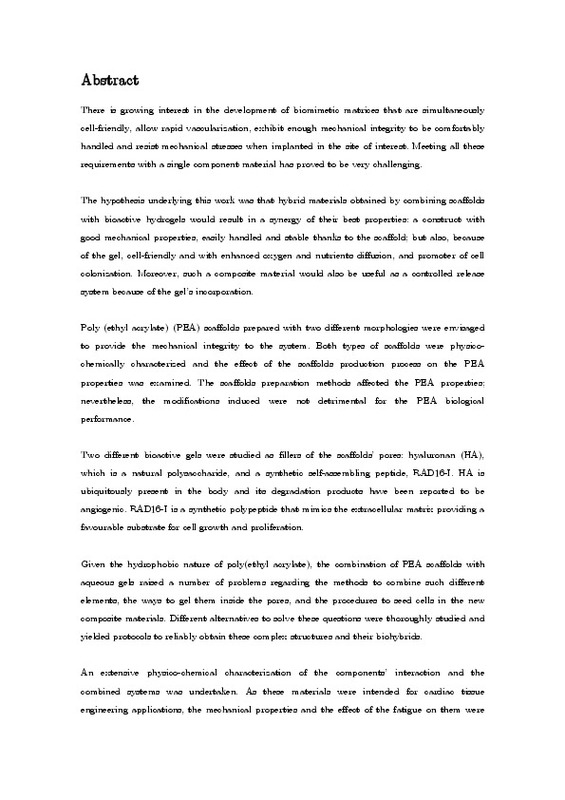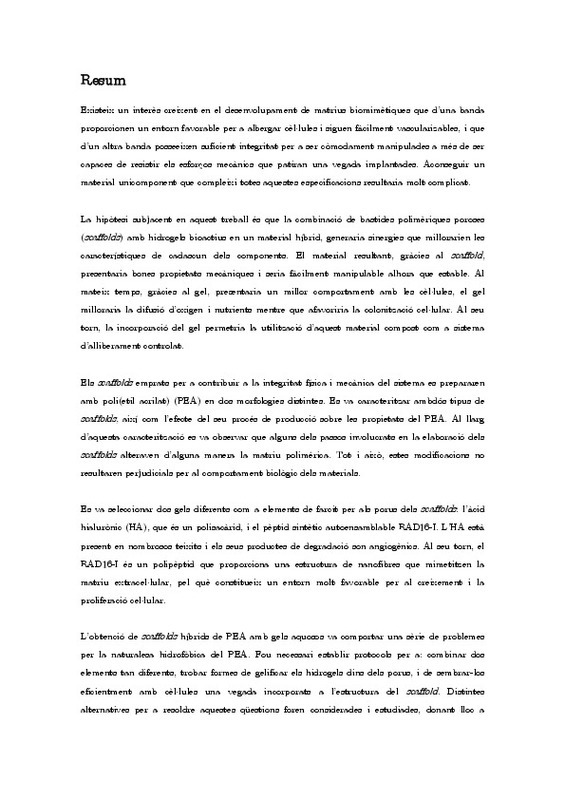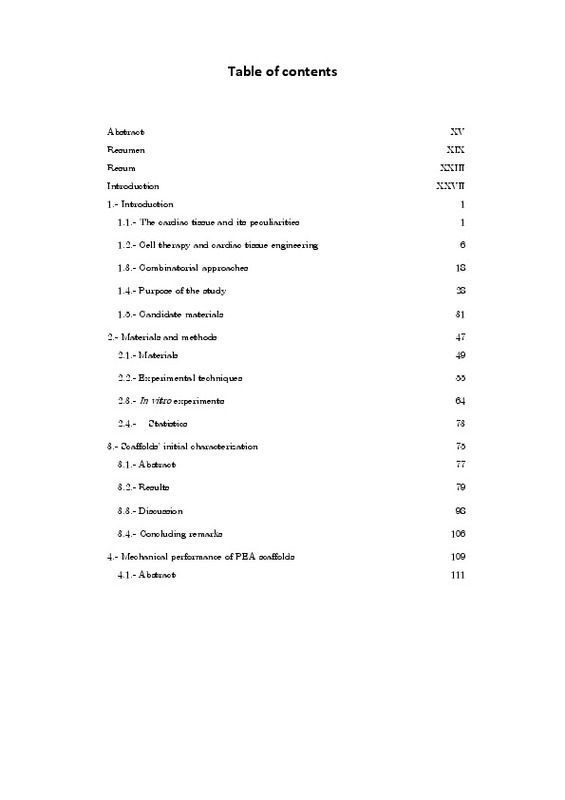- RiuNet repositorio UPV
- :
- Investigación
- :
- Tesis doctorales
- :
- Ver ítem
JavaScript is disabled for your browser. Some features of this site may not work without it.
Buscar en RiuNet
Listar
Mi cuenta
Estadísticas
Ayuda RiuNet
Admin. UPV
New scaffolding materials for the regeneration of infarcted myocardium
Mostrar el registro sencillo del ítem
Ficheros en el ítem
| dc.contributor.advisor | Monleón Pradas, Manuel
|
es_ES |
| dc.contributor.advisor | Vallés Lluch, Ana
|
es_ES |
| dc.contributor.author | Arnal Pastor, María Pilar
|
es_ES |
| dc.date.accessioned | 2015-01-16T11:02:37Z | |
| dc.date.available | 2015-01-16T11:02:37Z | |
| dc.date.created | 2014-12-19T08:00:21Z | es_ES |
| dc.date.issued | 2015-01-16T11:02:33Z | es_ES |
| dc.identifier.isbn | 978-84-9048-325-1 | |
| dc.identifier.uri | http://hdl.handle.net/10251/46129 | |
| dc.description.abstract | There is growing interest in the development of biomimetic matrices that are simultaneously cell-friendly, allow rapid vascularization, exhibit enough mechanical integrity to be comfortably handled and resist mechanical stresses when implanted in the site of interest. Meeting all these requirements with a single component material has proved to be very challenging. The hypothesis underlying this work was that hybrid materials obtained by combining scaffolds with bioactive hydrogels would result in a synergy of their best properties: a construct with good mechanical properties, easily handled and stable thanks to the scaffold; but also, because of the gel, cell-friendly and with enhanced oxygen and nutrients diffusion, and promoter of cell colonization. Moreover, such a composite material would also be useful as a controlled release system because of the gel’s incorporation. Poly (ethyl acrylate) (PEA) scaffolds prepared with two different morphologies were envisaged to provide the mechanical integrity to the system. Both types of scaffolds were physicochemically characterized and the effect of the scaffolds production process on the PEA properties was examined. The scaffolds preparation methods affected the PEA properties; nevertheless, the modifications induced were not detrimental for the PEA biological performance. Two different bioactive gels were studied as fillers of the scaffolds’ pores: hyaluronan (HA), which is a natural polysaccharide, and a synthetic self-assembling peptide, RAD16-I. HA is ubiquitously present in the body and its degradation products have been reported to be angiogenic. RAD16-I is a synthetic polypeptide that mimics the extracellular matrix providing a favourable substrate for cell growth and proliferation. Given the hydrophobic nature of poly(ethyl acrylate), the combination of PEA scaffolds with aqueous gels raised a number of problems regarding the methods to combine such different elements, the ways to gel them inside the pores, and the procedures to seed cells in the new composite materials. Different alternatives to solve these questions were thoroughly studied and yielded protocols to reliably obtain these complex structures and their biohybrids. An extensive physico-chemical characterization of the components’ interaction and the combined systems was undertaken. As these materials were intended for cardiac tissue engineering applications, the mechanical properties and the effect of the fatigue on them were studied. The different composite systems here developed were homogeneously filled or coated with the hydrogels, were easy to manipulate, and displayed appropriate mechanical properties. Interestingly, these materials exhibited a very good performance under fatigue. The use of the composite systems as a controlled release device was based on the possibility of incorporating active soluble molecules in the hydrogel within the pores. A release study of bovine serum albumin (BSA), intended as a model protein, was performed, which served as a proof of concept. The biological performance of the hybrid scaffolds was first evaluated with fibroblasts to discard the materials cytotoxicity and to optimize the cell seeding procedure. Subsequently, human umbilical vein endothelial cells (HUVECs) cultures were performed for their interest in angiogenic and vascularization processes. Finally, co-cultures of HUVECs with adipose-tissue derived mesenchymal cells (MSCs) were carried out. These last cells are believed to play an important role for clinical regenerative medicine, and their cross-talk with the endothelial cells enhances the viability and phenotypic development of HUVECs. Through the different experiments undertaken, hybrid scaffolds exceeded the outcome achieved by bare PEA scaffolds. | en_EN |
| dc.language | Inglés | es_ES |
| dc.publisher | Editorial Universitat Politècnica de València | |
| dc.rights | Reserva de todos los derechos | es_ES |
| dc.source | Riunet | es_ES |
| dc.subject | Scaffold | es_ES |
| dc.subject | hyaluronic acid/Hyaluronan | |
| dc.subject | poly(ethyl acrylate) | |
| dc.subject | self-assembling peptide gel | |
| dc.subject | controlled release | |
| dc.subject | cell seeding | |
| dc.subject.classification | MAQUINAS Y MOTORES TERMICOS | es_ES |
| dc.title | New scaffolding materials for the regeneration of infarcted myocardium | |
| dc.type | Tesis doctoral | es_ES |
| dc.identifier.doi | 10.4995/Thesis/10251/46129 | es_ES |
| dc.rights.accessRights | Abierto | es_ES |
| dc.contributor.affiliation | Universitat Politècnica de València. Departamento de Ingeniería Electrónica - Departament d'Enginyeria Electrònica | es_ES |
| dc.description.bibliographicCitation | Arnal Pastor, MP. (2014). New scaffolding materials for the regeneration of infarcted myocardium [Tesis doctoral]. Editorial Universitat Politècnica de València. https://doi.org/10.4995/Thesis/10251/46129 | es_ES |
| dc.description.accrualMethod | TESIS | es_ES |
| dc.type.version | info:eu-repo/semantics/publishedVersion | es_ES |
| dc.relation.tesis | 8120 | es_ES |
| dc.description.award | Premios Extraordinarios de tesis doctorales | es_ES |
Este ítem aparece en la(s) siguiente(s) colección(ones)
-
Tesis doctorales [5389]
-
Tesis. Editorial UPV [172]






